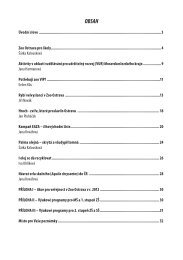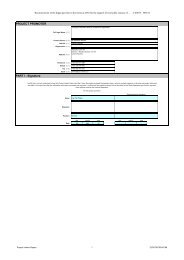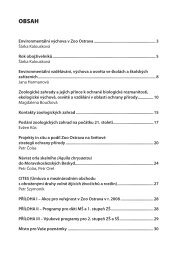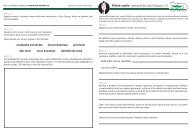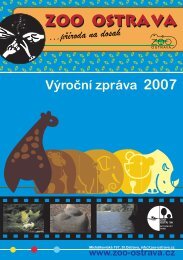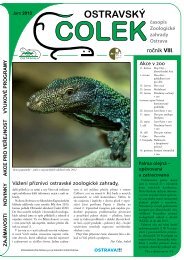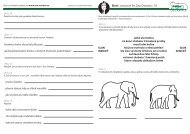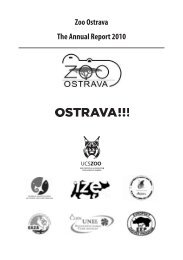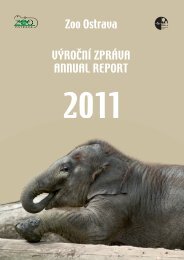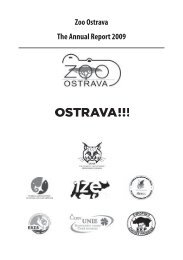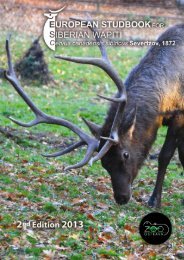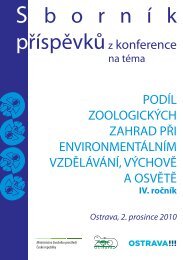výroÄnà zpráva 2009 ( 4,12 MB ) - Zoo Ostrava
výroÄnà zpráva 2009 ( 4,12 MB ) - Zoo Ostrava
výroÄnà zpráva 2009 ( 4,12 MB ) - Zoo Ostrava
- No tags were found...
Create successful ePaper yourself
Turn your PDF publications into a flip-book with our unique Google optimized e-Paper software.
60Double offspring in the southern ground hornbill reared at <strong>Ostrava</strong> <strong>Zoo</strong>Ivo FirlaSouthern ground hornbills (Bucorvus leadbeateri) have been successfully bred since 2007 at <strong>Ostrava</strong> <strong>Zoo</strong>.Following the failure to hand-rear the juvenile hatched in 2006, the bird hatched a year later was successfullyreared by parents. Seeing that the female laid each time two fertile eggs, the team was considering possibleuse of the other egg, as they wanted to avoid any artificial rearing. Options included placing one egg undera different female in a different zoo provided one was available with unfertilised eggs or attempting atnatural rearing of both chicks.In early December 2008, the birds started visiting their nest-box as with the previous years, first the femalewith the male following. Some 14 days later, on 16 December, the female laid the first egg and then anotherfour days after, on 20 December. The eggs were removed one by one, put into the incubator and replacedwith artificial eggs, but as they turned out to be unfertilised, the artificial eggs were removed and everyonebelieved the female would lay another clutch. This did happen and the female laid her third egg on 18 January,with another following four days after (on 22 January) as with the previous clutch. Again, these eggs were putinto the incubator one by one and replaced with artificial eggs.Following a week of incubation, the eggs were checked using a candle lamp and both found to have beenimpregnated. Then they were undergoing successful development. On 25 February, when the chick was readyto hatch and started to call, the egg was placed under the female and one artificial egg removed at the sametime. A day later, the egg was pre-hatched, with the chick intensely calling. On 27 February, the chick hatched,weighing 64 grams. Three days after, on 2 March, the chick from the fourth egg still left inside the incubatorhatched as well. As no suitable female under which the second chick could be placed was available in otherzoos at the moment, the team opted for the second alternative of attempting at rearing both chicks bya single female, based upon experience transferred from the colleagues at Prague <strong>Zoo</strong>. Placing both chicksimmediately upon hatching is not possible, with the different size of the chicks being the issue, where theolder bird will eat the food offered by the mother, leaving the younger chick starving. Thus, the younger birdsneed to be trained by hand-feeding to make sure they will able to take food properly. Once this was done, thechicks were exchanged on 4 March - five days after the first chick was hatched - where the chick brooded bythe female was replaced by the other chick and moved into the incubator, where it was fed by hand anotherfive days. Subsequently, there was another exchange and all was repeated. It resulted from routine checksand weighing that the parents were taking good care of each young bird and in fact did not matter the chickexchanges at all. As of 16 March, when the chicks were 15 and 18 days old, they were both left under themother. As there was no option of visual check if the younger and lesser chick would take enough food or not,both birds were weighed on a periodical basis, which made the team assured the parents' care of both younghornbills was excellent. The older chick attacked its younger sibling from time to time, namely in feeding.The inspection by weighing was carried out until about middle of May. Somewhere between day 82 and84, the young birds left the nest-box for the first time. Although already able to take food by themselves,the birds still begged from time to time, keeping themselves being fed by their parents. After blood wassampled for DNA testing, both juveniles were found to be females. Any critical periods occur namely in the



